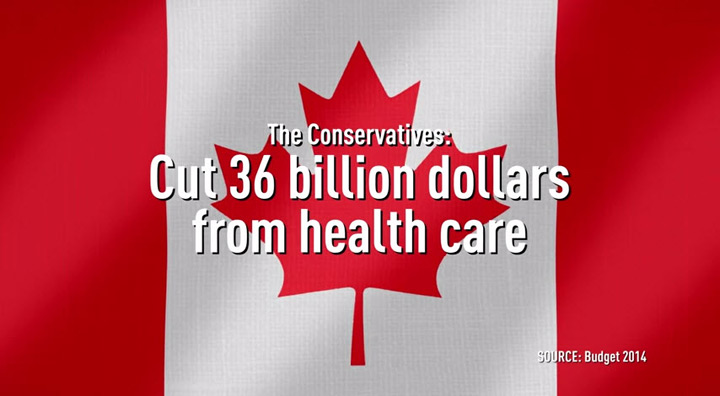Engage Canada, an anti-Conservative Party group, has a new ad that’s getting heavy play on Canadian television.

The ad looks at the Harper government’s record on health care, and makes several specific claims relating to the party’s policies.
Watch the ad below.
But how accurate are these claims? Let’s examine them.
1. The Conservatives cut $36 billion from health care
This isn’t really true: Health care transfers to the provinces are going up every year.
What Engage Canada is talking about here is a change to the growth rate of those transfers. Under the old formula, which was up for renewal, transfers were going to increase by 6 per cent every year. Under the new formula, introduced in the 2012 budget, transfers will continue to go up by 6 per cent until 2017-18.
In 2017-18, the transfers will increase by an amount tied to the growth rate in Canada’s GDP, or 3 per cent per year – whichever is larger.
According to a report released by the Council of the Federation, the provinces estimate that they will receive about $36 billion less under the new formula than the old one over ten years. While it’s true that the provinces will get less money than they would have under the old program’s parameters, calling it a “cut” is misleading.
2. Longer wait times
The ad said that this plan will mean longer wait times.
On its website, Engage Canada cites a Globe and Mail column from 2013 as the source of this claim. But the article actually quotes an Organization of Economic Cooperation and Development health economist, who states that more funding doesn’t necessarily help wait times. The economist argues that other countries that have successfully reduced wait times have done so by implementing wait time guarantees through penalties to hospitals and health authorities or giving patients more freedom to choose where they receive treatment.
In fact, the article is even titled, “Wait times: Money’s not the answer.”
The Canadian Institute for Health Information’s 2015 report on wait times said that hospitals are performing more procedures than they did five years ago, and wait times have remained stable. It does note that progress is uneven across the country though.
This is only an assessment of past performance, and it’s possible that things could get worse, particularly as Canada’s population ages.
3. Fewer nurses
This may be true, though it might not be due to Harper’s policies.
The source for this claim is the Ontario Nurses’ Association, which draws a direct link between the changes to federal funding and a lack of registered nurses in Ontario.
Back in 2013, Ontario’s then-Health Minister Deb Matthews agreed. ““It’s less money to reduce wait times, it’s less money to hire nurses, it’s less time to provide Ontario families and particularly Ontario seniors with the care that they need,” she said.
Canada-wide, it may be too early to say what the effects of these policies might be on the number of nurses, though there are signs that something is shrinking the nursing workforce. A June 2015 report from CIHI states that the number of nurses in Canada declined for the first time in two decades.
4. Cuts to women’s health
Here, Engage Canada cites the Canadian Women’s Health Network as its source.
It’s a good choice – the CWHN had to suspend its activities in 2014, due to lack of funds.
Specifically, Health Canada’s Women’s Health Contribution Program, which provided funding to various women’s health organizations across Canada (including CWHN), was cut in the 2012 budget. Several of these organizations have since closed.




Comments